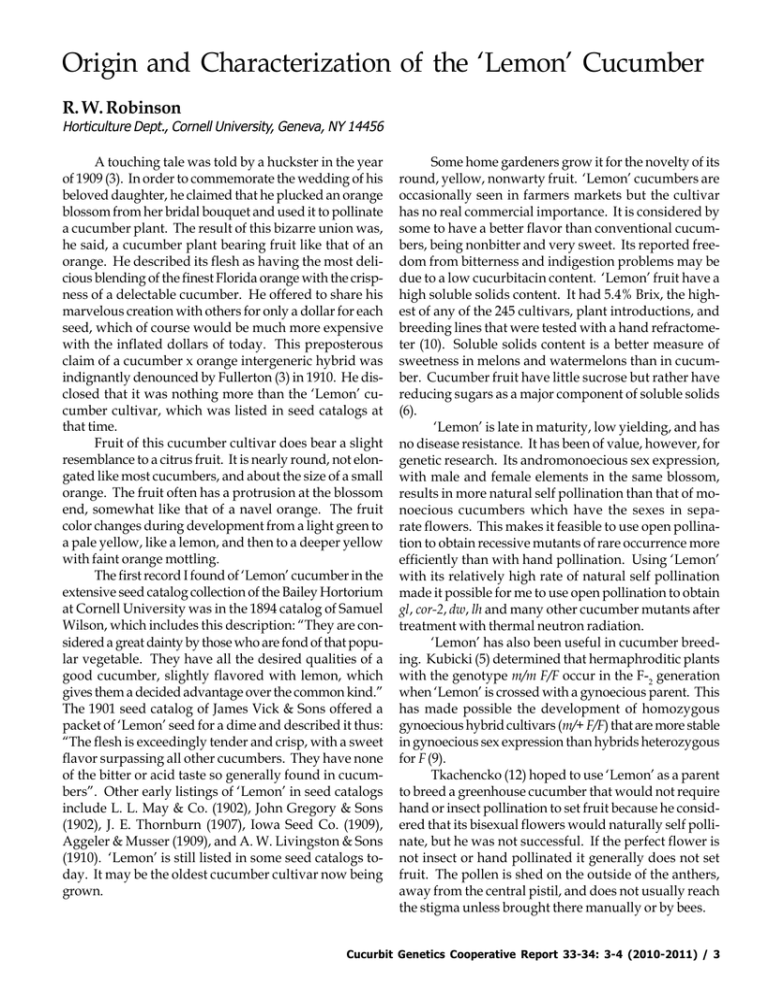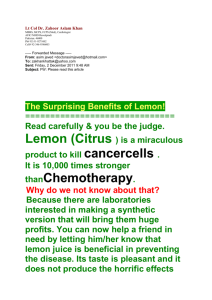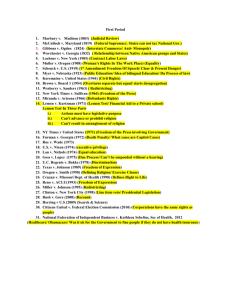Origin and Characterization of the ‘Lemon’ Cucumber R. W. Robinson
advertisement

Origin and Characterization of the ‘Lemon’ Cucumber R. W. Robinson Horticulture Dept., Cornell University, Geneva, NY 14456 A touching tale was told by a huckster in the year of 1909 (3). In order to commemorate the wedding of his beloved daughter, he claimed that he plucked an orange blossom from her bridal bouquet and used it to pollinate a cucumber plant. The result of this bizarre union was, he said, a cucumber plant bearing fruit like that of an orange. He described its flesh as having the most delicious blending of the finest Florida orange with the crispness of a delectable cucumber. He offered to share his marvelous creation with others for only a dollar for each seed, which of course would be much more expensive with the inflated dollars of today. This preposterous claim of a cucumber x orange intergeneric hybrid was indignantly denounced by Fullerton (3) in 1910. He disclosed that it was nothing more than the ‘Lemon’ cucumber cultivar, which was listed in seed catalogs at that time. Fruit of this cucumber cultivar does bear a slight resemblance to a citrus fruit. It is nearly round, not elongated like most cucumbers, and about the size of a small orange. The fruit often has a protrusion at the blossom end, somewhat like that of a navel orange. The fruit color changes during development from a light green to a pale yellow, like a lemon, and then to a deeper yellow with faint orange mottling. The first record I found of ‘Lemon’ cucumber in the extensive seed catalog collection of the Bailey Hortorium at Cornell University was in the 1894 catalog of Samuel Wilson, which includes this description: “They are considered a great dainty by those who are fond of that popular vegetable. They have all the desired qualities of a good cucumber, slightly flavored with lemon, which gives them a decided advantage over the common kind.” The 1901 seed catalog of James Vick & Sons offered a packet of ‘Lemon’ seed for a dime and described it thus: “The flesh is exceedingly tender and crisp, with a sweet flavor surpassing all other cucumbers. They have none of the bitter or acid taste so generally found in cucumbers”. Other early listings of ‘Lemon’ in seed catalogs include L. L. May & Co. (1902), John Gregory & Sons (1902), J. E. Thornburn (1907), Iowa Seed Co. (1909), Aggeler & Musser (1909), and A. W. Livingston & Sons (1910). ‘Lemon’ is still listed in some seed catalogs today. It may be the oldest cucumber cultivar now being grown. Some home gardeners grow it for the novelty of its round, yellow, nonwarty fruit. ‘Lemon’ cucumbers are occasionally seen in farmers markets but the cultivar has no real commercial importance. It is considered by some to have a better flavor than conventional cucumbers, being nonbitter and very sweet. Its reported freedom from bitterness and indigestion problems may be due to a low cucurbitacin content. ‘Lemon’ fruit have a high soluble solids content. It had 5.4% Brix, the highest of any of the 245 cultivars, plant introductions, and breeding lines that were tested with a hand refractometer (10). Soluble solids content is a better measure of sweetness in melons and watermelons than in cucumber. Cucumber fruit have little sucrose but rather have reducing sugars as a major component of soluble solids (6). ‘Lemon’ is late in maturity, low yielding, and has no disease resistance. It has been of value, however, for genetic research. Its andromonoecious sex expression, with male and female elements in the same blossom, results in more natural self pollination than that of monoecious cucumbers which have the sexes in separate flowers. This makes it feasible to use open pollination to obtain recessive mutants of rare occurrence more efficiently than with hand pollination. Using ‘Lemon’ with its relatively high rate of natural self pollination made it possible for me to use open pollination to obtain gl, cor-2, dw, lh and many other cucumber mutants after treatment with thermal neutron radiation. ‘Lemon’ has also been useful in cucumber breeding. Kubicki (5) determined that hermaphroditic plants with the genotype m/m F/F occur in the F-2 generation when ‘Lemon’ is crossed with a gynoecious parent. This has made possible the development of homozygous gynoecious hybrid cultivars (m/+ F/F) that are more stable in gynoecious sex expression than hybrids heterozygous for F (9). Tkachencko (12) hoped to use ‘Lemon’ as a parent to breed a greenhouse cucumber that would not require hand or insect pollination to set fruit because he considered that its bisexual flowers would naturally self pollinate, but he was not successful. If the perfect flower is not insect or hand pollinated it generally does not set fruit. The pollen is shed on the outside of the anthers, away from the central pistil, and does not usually reach the stigma unless brought there manually or by bees. Cucurbit Genetics Cooperative Report 33-34: 3-4 (2010-2011) / 3 Tkachencko (12) considered ‘Lemon’ to be so different from other cucumbers that he designated it as a distinct species, Cucumis sphaerocarpus, named after its round fruit. But it is C. sativus, of course, and only a few genes determine the major characteristics that distinguish ‘Lemon’ from other cucumber cultivars (13). Its andromonoecious sex expression is due to gene m and this gene is associated with nearly round fruit shape. The fruit shape of ‘Lemon’ is also influenced by the l gene for five fruit locules instead of the normal three. Its yellow-green immature fruit color is governed by yg . Gene n is responsible for the upright rather than pendant position of immature ‘Lemon’ fruit. Its protruding ovary is due to pr. The opposite leaf arrangement is determined by opp and the fasciation of some ‘Lemon’ plants is due to fa. All of these genes are recessive and when ‘Lemon’ is crossed with a white spined monoecious cucumber the only outward evidence of ‘Lemon’ in the hybrid is its black fruit spines. Many of the characteristics that make ‘Lemon’ unique are genetically connected by linkage or pleiotropy. Andromonoecious sex expression, negative geotropic peduncle response, round fruit shape, protruding ovary, opposite leaves, and fasciation are completely linked or are pleiotropic. Genes for more than three fruit locules and for yellow fruit color are also on the same chromosome but are less closely linked with the andromonoecious sex expression gene. Some of the unique characteristics of ‘Lemon’ cucumber may have existed since antiquity. Chakravarty (2) stated that a Sumerian cucumber grown in Iraq thousands of years ago had short ovoid or round fruit. In 1859 Naudin (7) wrote of a land race of cucumber from India having fruit with five locules instead of the customary three. A cucumber plant with opposite leaf arrangement was portrayed in an ancient herbal (8) and cucumbers with fruit shape like ‘Lemon’ were depicted in herbals of the 16th century (4). Almost 2000 years ago Pliny the Elder wrote about a cucumber shaped like a quince and golden in color, a description resembling the fruit of Lemon’ (1). But it likely was not ‘Lemon’ or any other cucumber since Pliny stated that its fruit separated from the vine when mature. Fruit dehiscence is characteristic of C. melo, not C. sativus. ‘Lemon’ cucumber is also distinct from the Vine Peach, Cucumis melo var. chito, which has been known as ‘Lemon Cucumber’ (11). The cultivar ‘Lemon’ apparently originated in the late 19th century. An unresolved question is its parentage and where its unique combination of associated characteristics is derived from. Literature cited 1. Bostock, J. and H. T. Riley. 1886. The Natural History of Pliny. Vol. 4. Henry Bohn, London. 523 pp. 2. Chakravarty, H. L. 1966. Monograph on the Cucurbitaceae of Iraq. Iraq Ministry of Agriculture Tech. Bull. 133. 3. Fullerton, H. B. 1910. Fakes and facts. Long Island Agronomist 3 (13): 10. 4. Janick, Jules and Harry S. Paris. 2006. The cucurbit images (1515-1518) of the Villa Farnesina, Rome. Ann. Bot. 97: 165-176. 5. Kubicki, B. 1965. New possibilities of applying different sex types in cucumber breeding. Genet. Polonica 6: 241-250. 6. McCombs, C .L., H. N. Sox, and R. L. Lower. 1976. Sugar and dry matter content of cucumber fruits. HortSci. 11: 245247. 7. Naudin, C. 1859. Especes et des variates du genre Cucumis. Ann. Ser. Nat. Ser. 4. 11:5-87. 8. Paris, H. 2006. Oral presentation at Cucurbitaceae 2006 Meeting, Asheville NC. 9. Robinson, R. W. 1999. Rationale and methods for producing hybrid cucurbit seed. Jour. New Seeds 1: 1-47. 10. Robinson, R. W. 1987. Genetic variation in soluble solids of cucumber fruit. Cucurbit Genet. Coop. Rpt. 10: 9. 11. Tapley, W. T., W. D. Enzie, and G. P. van Eseltine. 1937. The Vegetables of New York. Vol. 1, Part IV. J. B. Lyon Co., Albany NY. 12. Tkachenko, N. N. 1925. Preliminary results of a genetic investigation of the cucumber – Cucumis sativus L. Bull. Appl. Pl. Breed. Ser. 2, 3: 311-356. 13. Youngner, V. B. 1952. A study of the inheritance of several characters in the cucumber. PhD thesis. Univ. Minnesota. 4 / Cucurbit Genetics Cooperative Report 33-34: 3-4 (2010-2011)






